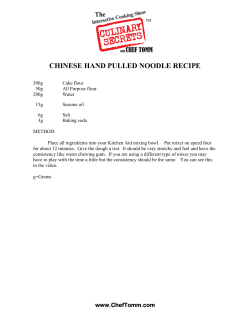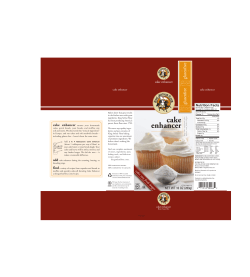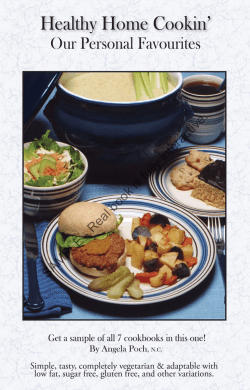
Beyond Rice Flour - Hy-Vee
Judy Fitzgibbons, MS, RD, LD Dee Sandquist, MS, RD, LD Nutritional Concerns When you were diagnosed: As you heal: 1. Replenish 2. Support health No More Gluten-free Means: Avoid Dairy (temporary) Typical foods: Milk Ice cream Cottage cheese Nutrient Concerns: Calcium Vitamin D Riboflavin Potassium Why Worry? Calcium Strong bones Fractures Osteoporosis How much: Children: 800 mg/day Most adults: 1,000 mg/day Consider: +200 – 400 mg/day for catch-up Vitamin D (The “new” vitamin) Strong bones Enhanced calcium absorption Muscle strength Protect against cancer, diabetes, heart disease, stroke, memory loss, dementia, autoimmune diseases? “General” well-being How much? 400 IU/ day (under 60) 800 to 1,000 IU/day (60 and over) Check vitamin D level No More Gluten-free Means: Avoid wheat, barley, rye Nutrient Concerns: Enriched flour Enriched/fortified flour, Enriched/fortified cereals Bran, wheat germ 100% whole wheat, semolina, durum flour Bread, pasta, muffins, pancakes, waffles, biscuits, doughnuts, cookies, cakes, English muffin, . . . . . cereals: Thiamin Niacin Riboflavin Iron Folic acid (folate) Whole grains Fiber Magnesium Why Worry? Thiamin, Niacin, Riboflavin Folate “B” vitamins Nerve function Metabolism of carbohydrates and proteins How much? Thiamin: 1.1 - 1.2 mg/day Niacin: 14 – 16 mg/day Riboflavin: 1.1 – 1.3 mg/day Fetal brain, spinal cord development Spina bifida Normal blood cells (Megaloblastic anemia) How much? 400 mcg/day Why Worry? Iron Magnesium Oxygen transported from Bone structure lungs to vital organs Protect against diabetes General well-being How much: Pre-menopausal: 18 mg/d Men/Post-menopausal: 10 mg/day How much: 320-420 mg/day Why Worry? Fiber General gut health Protect from colon cancer Soluble (oats, barley) Lower cholesterol Lower blood sugars How much? 25 - 35 grams day NuVal: Overall Nutritional Value The Number: How do they get it? Scores 1 to 100 Add up the “good” stuff: Calcium, iron, protein, etc. Fiber, antioxidants Ingredients: whole grains Divide by the “problem” stuff: Added sugar Saturated fat, trans fat Sodium Cholesterol The higher the score, the better the nutritional value Example: Banana: NuVal 91 Full Throttle: NuVal 1 NuVal: Overall Nutritional Value 8 NuVal and Gluten-free: Traditional NuVal Scores Gluten-free Scores Pasta Regular NV = 61 Whole Wheat NV = 91 Cereals Most NV = 22 – 26 Wheaties NV = 28 Bread HV Cottage White NV = 24 HV 100% W Wheat NV = 32 Pasta Brown Rice NV = 29 – 81 Cereals Most NV = 11 – 25 Breads Pamela’s Bread Mx NV = 23 Udi’s White Sand. NV = 24 Kinnick. Brown Snd NV = 38 Let’s Make up the Loss Non-grain Super Foods Gluten-free Super Grains Leafy greens Quinoa Legumes: beans, soy, lentils Flax Nuts: almonds, walnuts, Chia peanuts, etc. Montina Coconut flour, de-fatted Super Foods: Leafy Greens Why? How? High in magnesium Kale Roast Add to salads Stir-fry, add to soups Spinach Sandwiches Replace part of lettuce in salads Add chopped to meatloaf, lasagna, soups Fiber Vitamin A Antioxidants/Phytonutrients Superfoods: Legumes (beans) Why? How? Fiber, especially soluble Add canned to salads, Potassium soups Lentils to replace ground beef Black beans “gentler” Magnesium Protein Superfoods: Nuts and Seeds Why? How? Assorted minerals All: manganese Almonds: magnesium, calcium Hazelnuts, walnuts, pistachios: copper Brazil nuts: selenium Nut butters on gf crackers or apple slices Peanut, almond, sunflower, soy Add chopped nuts to cooked cereal, yogurt Sprinkle nuts on fruit or tossed salad Make GF trail mix Superfoods: Chia Why? Each 15 gram (1/2 oz) serving of Omega 3 Chia contains: Omega 3 fatty acids-equal to 250 grams (9 oz) of salmon Antioxidants-equal to 15 grams of blueberries Fiber-equal to 17 grams of bran Protein-equal to 44 grams of kidney beans Calcium-equal to 3 oz whole milk Magnesium-equal to 73 grams of spinach Iron-equal to 103 grams of spinach Superfoods: Chia How? Use ½ cup water to one scoop chia for a gel; add cinnamon for a breakfast treat Substitute 1 -2 Tbsp chia flour in recipes Use chia seeds in salads, soups, muffins, breads, cookies Use chia seeds for an ice cream topping Superfoods: Montina Why? How? Adds protein and fiber Use in breads, cookies, Brown in color so adds a muffins Baking mix can be used as a “mix” in breads, cookies, muffins Baking supplement is 100% Indian Rice Grass “whole grain” appearance Superfoods: Coconut Flour Why? How? Adds flavor Substitute 10 – 30% of flour Fiber from the coconut meat with coconut flour Contains natural sugar from the coconut so may need less sugar in recipe after most of the oil has been extracted Regulatory Agencies Food and Drug Adminstration (FDA) o Food Allergen Labeling and Consumer Protection Act, 2006 o Eight allergens must be included on the food label: Wheat, milk, eggs, fish,crustacean shellfish, tree nuts, soy, peanuts o Look for barley, rye, oats, and malt Regulatory Agencies U.S. Department of Agriculture (USDA) Regulates meat, poultry, and egg products including mixed food products containing more than 3% raw meat, at least 2 % cooked meat, or at least 2 % cooked poultry. USDA products that may contain gluten Lunch meats, hotdogs, canned meats, prepackaged seasoned “fresh” chicken products. No mandatory allergen labeling rule If you see “modified food starch” or “dextrin” contact the manufacturer (on a USDA product.) USDA products that may contain gluten Lunch meats, hotdogs, canned meats, prepackaged seasoned “fresh” chicken products. No mandatory allergen labeling rule If you see “modified food starch” or “dextrin” contact the manufacturer (on a USDA product.) Natural Flavors FDA product will state “wheat” Barley = malt Rye = Rye flavoring USDA product cannot contain protein in “natural flavor” so it does not contain undeclared wheat, barley, or rye Gluten-Free Labeling Will apply to both FDA and USDA foods 20 parts per million or less of gluten Bag of candy with 1 million red candies, but 20 were blue One ounce of bread containing 20 ppm gluten = 35 slices of bread Naturally Gluten Free Grains Not Specified Gluten Free May contain gluten due to cross contamination (i.e. nuts, seeds, buckwheat, cornmeal, sweet rice) 41% samples contained 8.5 to 2925 ppm 32% contained > 20 ppm Thompson, Tricia and Lee, Anne Roland, JADA ,June 2010, p 937 - 939 Zero Gluten vs. Gluten Free Impossible currently to test a food to 0 ppm Food labeled “gluten free” contains <20 ppm regardless if gluten in ingredients of unintentional cross contamination Wheat Starch and Modified Food Starch Removes most of the protein leaving starch Final product must contain < 20 ppm Confusing allergen advisory statements “Made in a facility that also manufactures products contain gluten.” “Produced in a facility that uses wheat, milk soy, almonds, pecans.” No federal guidelines for allergy advisory statements (different from Food Allergen Labeling and Consumer Protection Act. More Resources Hy-Vee www.hy-vee.com www.gluten.net Recipes Gluten-free shopping list of Hy-Vee brands Store dietitian locator To view this presentation: Hy-vee.com Go to store finder: Mt. Pleasant or Cedar Rapids Johnson Ave. Food Store
© Copyright 2025





















